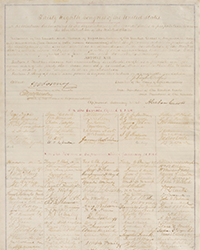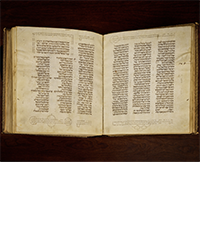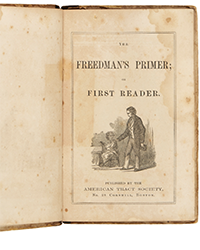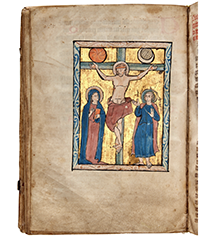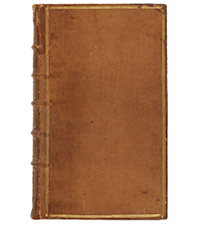Shapero Rare Books has published a catalogue entitled Showcase 2025. My best guess for the title is that this is such a collection of important and historic works that they belong in a showcase, rather than hidden away on a shelf. Without a need to say more, we will open the pages and take a look at a few of the 100 items being offered.
First up we start with the beginning of the printed word. That is, of course, the Gutenberg Bible. Published in 1455, it was the first printed book using movable type. This allowed for the mass distribution of the printed word. Knowledge could now be shared with a large audience, never before possible. It raised the West from its century-long “Dark Ages” to the flowering of learning and arts of the Renaissance. It can reasonably be called the most important book ever printed. Gutenberg Bibles effectively disappeared from the marketplace almost half a century ago, but it is still possible to find a page from one available. These come from an incomplete copy bookseller Gabriel Wells broke apart in the 1920s. These leaves came with a bibliographic essay by A. Edward Newton (present here). This “Noble Fragment” from Exodus contains an inscription from Newton. Item 1. Priced at £110,000 (British pounds or approximately US $145,357).
It was a spectacular fair, the first of what became known as World's Fairs. It was held in London and called the Great Exhibition of the Works of Industry of All Nations. Forty-two nations participated in the 1851 fair. Over 100,000 objects were displayed by 14,000 exhibitors. Six million people attended. It was the dream of Prince Albert, Queen Victoria's husband. The highlight was the Crystal Palace. It was a structure of glass and iron beams. It measured 1858 feet long by 408 feet wide. It rose to 128 feet in the air. Exhibits were focused on four subjects, machinery, manufactures, fine arts and raw materials. Among the items displayed were steam engines, hydraulic presses, carriages, firearms, enamels, textiles, and the 186 carat Koh-i-Noor diamond. Three years after the fair, Dickinson Bros. published an illustrated look at the fair, Dickinson's Comprehensive Pictures of the Great Exhibition of 1851, from the originals painted for H.R.H. Prince Albert. It is a chance to see the sights of the fair long gone. The Crystal Palace was so well-loved by the British people that it was moved to a new location, but in 1936 was destroyed by fire. Glass and iron don't burn, but the wooden floors did. Item 54. £22,500 (US $29,825).
Sir Richard Burton is known for his travel books, he having explored numerous lands, at times disguised as a local. Burton was not a well-liked man, noted particularly for his unpleasant relationship with fellow explorer John Hanning Speke. Fortunately, great writing does not require an easy-going personality. While mostly known for his explorations, Burton was also a diplomat, though not given major posts. He also wrote on topics other than travels, and that is what item 59 is. It is an unpublished autograph manuscript of a planned book of Greek Proverbs. It consists of 182 such proverbs, including English translations. It includes a letter from Dr. Georgio G. Cavadia to Burton in 1879, when Burton was Consul at Trieste, offering information on some Greek proverbs. The manuscript was found with Burton's effects at his home in Trieste when he died, having escaped Lady Burton's burning of many of his papers to protect his reputation. Item 59. £37,500 (US $49,765).
This book was a massive undertaking, a history of the world. It wasn't quite the challenge it would be today as there was much less history to recount when it was published, July 12, 1493. Still, author Hartmann Schedel didn't cut any corners. He went back to the beginning, Creation, using the Bible as his source. He had no other sources for a few millennia, and even after those times, his resources were limited and not always accurate. Nonetheless, he presented humanity with the greatest history book available at the time. Schedel didn't limit himself to ancient times as he wrote about the current world as well, and here many of his sources were far more accurate. What is even more notable about this book is the number of illustrations, which far exceeded previous books. There are over 1,800 woodcuts, although he did occasionally cheat by using one more than once. Perhaps with a book this size he figured no one would notice the reuse. The title of the book is Liber Cronicarum, usually called in English the Nuremberg Chronicle. He provided illustrations of major cities including Paris, Rome, Venice, Vienna, Constantinople, and Jerusalem (before and after its destruction). Added to those cities was Nuremberg. That was Schedel's home town and he wanted to promote it by showing it as one of the most important cities in the world. The printer was Anton Koberger, the woodcuts created by the shop of Michael Wolgemut. It is believed some were created by a young Albrecht Durer. Durer was Koberger's godson and apprenticed for Wolgemut. This copy is unusual and particularly valuable as it features contemporary hand-coloring. Item 2. £375,000 (US $498,744).
The next book is commemoration of a spectacular event, though the last of its kind. It celebrates the coronation of Tsar Nicholas II of Russia in 1896. His father died fairly young, only 49 years of age, throwing Nicholas into the role at the age of 28. He was not well-prepared. Shapero describes this book as “one of the greatest achievements of the Russian presses." It comes in a binding worthy of a great book. The book provides a history of the House of Romanov, a detailed description of the coronation, and the procession through the streets of Moscow to the chapel. The plates show views of the event, pictures of the royal family, and event programs and menus. Along with photographs, illustrations were provided by some of the great artists of the time. Published in 1899, three years after the coronation, this is the French edition of the remembrance, Les Solennités de Saint Couronnement. Nicolas has generally been considered by historians as a ruler who meant well but was over his head and often relied on bad advice. His one fatal flaw, and it was literally fatal, was his unwillingness to cede any of his authoritarian power to the people, even as it became apparent that he could not hold onto it all. He, his wife and children all paid for his stubbornness with their lives, even Anastasia. Item 62. £250,000 (US $332,412).
Shapero Rare Books may be reached at +44 (0)20 7493 0876 or rarebooks@shapero.com. Their website is www.shapero.com.


